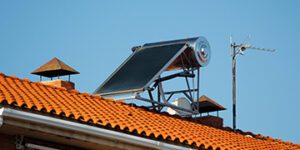 Scientists at the National Research Centre, Egypt have demonstrated that black tin anodised aluminium is 17% more heat efficient for flat panel solar water heaters than standard black paint coatings. Solar water heaters, using sunlight to heat domestic water, are expected to be an important step towards tackling climate change, supplying up to 35% of demand by 2050.
Scientists at the National Research Centre, Egypt have demonstrated that black tin anodised aluminium is 17% more heat efficient for flat panel solar water heaters than standard black paint coatings. Solar water heaters, using sunlight to heat domestic water, are expected to be an important step towards tackling climate change, supplying up to 35% of demand by 2050.
Around 250 million dwellings used solar water heaters on rooftops in 2020, including flat panel and evacuated tube designs, both of which are used in different types of climate. Flat panels traditionally use a black paint such as Thurmolox, or ‘selective’ coatings based typically based on chrome or nickel that may be undesirable or expensive. Black paint coatings absorb more heat but also release more energy. More efficient, sustainable and cost-effective solutions are needed.
The Egyptian team compared the performance of the tin anodised aluminium panel, made using stannous sulphate, to a black paint panel across a range of daytime temperatures and found a significantly higher efficiency for tin. Temperatures achieved were up to 10°C higher. Average heat conversion efficiency was 62%, about 17% better performance than the paint.
A recent International Energy Authority (IEA) report has highlighted the use of solar thermal water and space heating in residential buildings in reducing the use of fossil fuels. They forecast an increase in total energy from the current 1.6EJ (ExoJoules) to 2.2EJ in 2026 or 2.8EJ in a Net Zero Scenario. In the latter case this would equate to increasing the number of solar water heaters from 250 million in 2020 to 400 million by 2030 and 1,200 million by 2050.
The present work may provide an important new route towards making solar water heater systems more cost-effective and able to contribute a greater share of domestic heat demand per household.
Egyptian Journal of Chemistry, October 2021
Lead author contact, National Research Centre, Egypt
< Back to Solar Technologies
< Back to New Technologies
